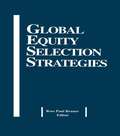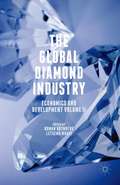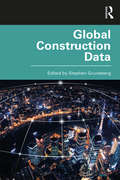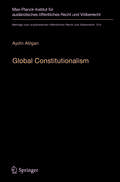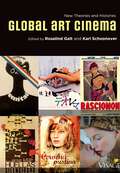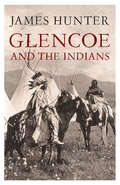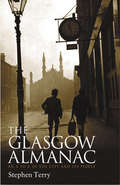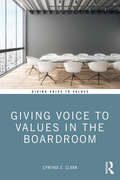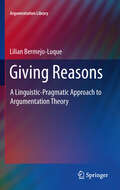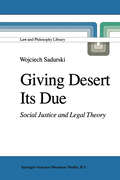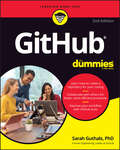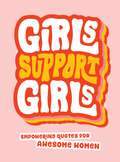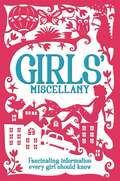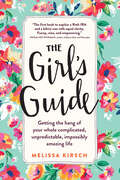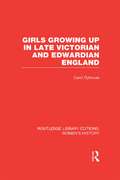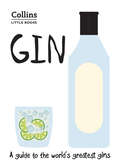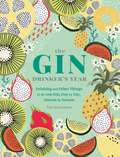- Table View
- List View
Global Equity Selection Strategies
by Ross Paul BrunerFirst Published in 1999. Routledge is an imprint of Taylor & Francis, an informa company.
The Global Diamond Industry: Economics and Development Volume II
by Roman Grynberg Letsema MbayiThe Global Diamond Industry: Economics and Development brings together a collection of papers covering various aspects of the diamond industry including economics, law, history, sociology and development across two volumes.
Global Construction Data
by Stephen GrunebergGlobal construction data is vital for contractors, governments, international organisations, policy makers, academic researchers and statisticians. As the global population of the world expands, the sustainability of the built environment raises the political agenda and the need to manage infrastructure and buildings in both urban and rural contexts becomes ever more pressing. How much more can the built environment grow and how can it be managed sustainably? This edited volume addresses how we can find a possible way through the inconsistencies between national construction data sets to devise a consistent approach to national construction data to further the global sustainability agenda and inform policy making. This search begins in Part I, which looks at the methods and definitions used in construction statistics in different countries. Part II considers examples of different types of construction data from the cost of materials, measuring work on high rise buildings and existing stock. In Part III, the authors consider construction data internationally, beginning with the problem of comparing data in different countries using exchange rates and purchasing power parities (PPPs), comparing innovation processes in different countries and looking at the provision of building design internationally. In Part IV, the international theme is continued by comparing accounting practices and company performance in different countries and concludes with an international comparison of construction industries. This book raises awareness of the significance of the construction industry globally and the importance of data to measure it. It informs the discussion of the best ways of handling the consequences of policies affecting the built environment and the effect of the built environment on the rest of the economy and society. It is essential reading for international economists, construction industry consultants, policy makers, construction statisticians and academics.
Global Construction Data
by Stephen GrunebergGlobal construction data is vital for contractors, governments, international organisations, policy makers, academic researchers and statisticians. As the global population of the world expands, the sustainability of the built environment raises the political agenda and the need to manage infrastructure and buildings in both urban and rural contexts becomes ever more pressing. How much more can the built environment grow and how can it be managed sustainably? This edited volume addresses how we can find a possible way through the inconsistencies between national construction data sets to devise a consistent approach to national construction data to further the global sustainability agenda and inform policy making. This search begins in Part I, which looks at the methods and definitions used in construction statistics in different countries. Part II considers examples of different types of construction data from the cost of materials, measuring work on high rise buildings and existing stock. In Part III, the authors consider construction data internationally, beginning with the problem of comparing data in different countries using exchange rates and purchasing power parities (PPPs), comparing innovation processes in different countries and looking at the provision of building design internationally. In Part IV, the international theme is continued by comparing accounting practices and company performance in different countries and concludes with an international comparison of construction industries. This book raises awareness of the significance of the construction industry globally and the importance of data to measure it. It informs the discussion of the best ways of handling the consequences of policies affecting the built environment and the effect of the built environment on the rest of the economy and society. It is essential reading for international economists, construction industry consultants, policy makers, construction statisticians and academics.
Global Constitutionalism: A Socio-legal Perspective (Beiträge zum ausländischen öffentlichen Recht und Völkerrecht #275)
by Aydin AtilganThis book provides insights into the viability of the idea of global constitution. Global constitutionalism has emerged as an alternative paradigm for international law. However, in view of the complex and varied structure of contemporary constitutionalism, in reality it is extremely difficult to use constitutional law to provide a new paradigm for international law. The book argues that the cultural paradigm can offer functional tools for the global constitutionalism discourse. In other words, global constitutionalism could be handled in the context of a global “constitutional culture” instead of a global constitution. This would provide a more realistic basis for discussing global constitutionalization of a society as diverse as the international community, where a globalized polity and a globalized legal system have not yet been achieved.
A Global Atlas of Atolls
by Walter M. Goldberg Eugene C. RankeyScattered like dots rising from the deep across vast expanses of the world’s tropical and subtropical oceans, atolls with their turquoise lagoons and reefs teeming with colorful marine life have captured the public imagination. They have also been the homeland of millions of people for millennia as various groups of migrants spread across the far reaches if the Pacific, Indian and Western Atlantic regions. Developed from recently available satellite data, A Global Atlas of Atolls presents high-quality details of 475 atolls across the globe, characterizing aspects of the atoll rim, the lagoon, and their coral reef communities in unprecedented detail. In synthesizing and enhancing understanding of these unique seascapes, this volume provides a distinct compendium of descriptions and images, as well as documentation of the environmental conditions of winds, waves, and tides and a summary of the background literature for each atoll area. There is no comparable work. After an introduction that includes a glossary of terms, each atoll is documented in the form of an atlas written for scientists, but accessible to any diver or reader interested in these spectacular reef-island habitats. This book also describes some current challenges and perspectives on their future. It will be useful as a reference work for marine scientists, while providing a minimum of technical jargon for those who are not scientists, but who enjoy reading about exotic places with unusual attributes.
A Global Atlas of Atolls
by Walter M. Goldberg Eugene C. RankeyScattered like dots rising from the deep across vast expanses of the world’s tropical and subtropical oceans, atolls with their turquoise lagoons and reefs teeming with colorful marine life have captured the public imagination. They have also been the homeland of millions of people for millennia as various groups of migrants spread across the far reaches if the Pacific, Indian and Western Atlantic regions. Developed from recently available satellite data, A Global Atlas of Atolls presents high-quality details of 475 atolls across the globe, characterizing aspects of the atoll rim, the lagoon, and their coral reef communities in unprecedented detail. In synthesizing and enhancing understanding of these unique seascapes, this volume provides a distinct compendium of descriptions and images, as well as documentation of the environmental conditions of winds, waves, and tides and a summary of the background literature for each atoll area. There is no comparable work. After an introduction that includes a glossary of terms, each atoll is documented in the form of an atlas written for scientists, but accessible to any diver or reader interested in these spectacular reef-island habitats. This book also describes some current challenges and perspectives on their future. It will be useful as a reference work for marine scientists, while providing a minimum of technical jargon for those who are not scientists, but who enjoy reading about exotic places with unusual attributes.
Global Art Cinema: New Theories and Histories
by Rosalind Galt Karl Schoonover"Art cinema" has for over fifty years defined how audiences and critics imagine film outside Hollywood, but surprisingly little scholarly attention has been paid to the concept since the 1970s. And yet in the last thirty years art cinema has flourished worldwide. The emergence of East Asian and Latin American new waves, the reinvigoration of European film, the success of Iranian directors, and the rise of the film festival have transformed the landscape of world cinema. This book brings into focus art cinema's core internationalism, demonstrating its centrality to understanding film as a global phenomenon. The book reassesses the field of art cinema in light of recent scholarship on world film cultures. In addition to analysis of key regions and films, the essays cover topics including theories of the film image; industrial, aesthetic, and political histories; and art film's intersections with debates on genre, sexuality, new media forms, and postcolonial cultures. Global Art Cinema brings together a diverse group of scholars in a timely conversation that reaffirms the category of art cinema as relevant, provocative, and, in fact, fundamental to contemporary film studies.
Global Art Cinema: New Theories and Histories
by Rosalind Galt Karl Schoonover"Art cinema" has for over fifty years defined how audiences and critics imagine film outside Hollywood, but surprisingly little scholarly attention has been paid to the concept since the 1970s. And yet in the last thirty years art cinema has flourished worldwide. The emergence of East Asian and Latin American new waves, the reinvigoration of European film, the success of Iranian directors, and the rise of the film festival have transformed the landscape of world cinema. This book brings into focus art cinema's core internationalism, demonstrating its centrality to understanding film as a global phenomenon. The book reassesses the field of art cinema in light of recent scholarship on world film cultures. In addition to analysis of key regions and films, the essays cover topics including theories of the film image; industrial, aesthetic, and political histories; and art film's intersections with debates on genre, sexuality, new media forms, and postcolonial cultures. Global Art Cinema brings together a diverse group of scholars in a timely conversation that reaffirms the category of art cinema as relevant, provocative, and, in fact, fundamental to contemporary film studies.
Glencoe and the Indians
by James HunterIn 1876, they wipe out General George A. Custer and his 7th Cavalry at the Battle of the Little Bighorn. Chief Sitting Bull and his Sioux people then flee from the United States to Canada. There, in the autumn of 1877, the Sioux are joined by the remnants of the latest Indian nation to make a stand against the US Army, the Nez Perce. Their survivors are led by Chief White Bird.A young man follows White Bird to Sitting Bull's camp. He is White Bird's close relative and aims to tell the story of the Nez Perce War from the Nez Perce point of view. This young man's name is Duncan McDonald. Descended from chiefs of the Nez Perce and from chiefs of Scotland's most formidable clan, Duncan's family - first as Highlanders, then as Native Americans - have twice been victims of massacre and dispossession.Written with the help of Duncan McDonald's present-day kinsfolk on the Flathead Indian Reservation in Western Montana, this real-life family saga spans two continents and more than thirty generations to link Scotland's clans with the native peoples of the American West.
Glasgow Almanac: An A-Z of the City and its People
by Stephen TerryThe contents of this Ebook first appeared in the Glasgow Evening Times over the course of the last decade as 250-word vignettes on people, places and happenings. They are therefore concise and to the point and allow easy access to the history of Glasgow. Arranged thematically The Glasgow Almanac covers the social history of the city from its earliest beginnings. The chapter headings are: Architecture, Education, Entertainment, Food and Drink, Law and Crime, Medicine, Religion, Shipbuilding, Sport, Trade, Transport, War and Death. At over 115,000 words this is one of the most comprehensive and affordable Ebooks yet written on all aspects of the city and its people. Arranged with a full index it is be an essential companion tool for anyone requiring knowledge on the city, its people and its history.
Giving Voice to Values in the Boardroom (Giving Voice to Values)
by Cynthia E. ClarkThis book takes the central issues facing board members today and applies the giving voice to values framework while also providing insights from practicing board members who have faced these issues. It covers such topics as strategic planning and monitoring, director independence, privacy and cyber risk, executive compensation and CEO succession planning. With this book, readers will also grapple with the conflicts of interest that might arise in the director selection process, role of the nominating committee and the compensation committee in order to cultivate more optimal board dynamics. The principles of giving voice to values start by asking a deceptively simple question: ‘What if you were going to act on your values—what would you say and do?’ The book then provides an overview of the current landscape of corporate governance along with the major rules and director duties applicable to the board of directors. The book’s latter chapters contain a series of five scenarios common to the board of directors that are presented as a set of “Board Challenges” involving the tensions often found in board work. In Giving Voice to Values in the Boardroom, the author, Cynthia E. Clark, provides practical strategies for board members and other constituents of corporate governance to deal with these challenges. These cases are designed to help users of the book implement prescripting and action planning. Each case will also have discussion questions about the stakes and stakeholders, common reasons and rationalizations and examples of how firms and governance professionals have handled similar board challenges.
Giving Voice to Values in the Boardroom (Giving Voice to Values)
by Cynthia E. ClarkThis book takes the central issues facing board members today and applies the giving voice to values framework while also providing insights from practicing board members who have faced these issues. It covers such topics as strategic planning and monitoring, director independence, privacy and cyber risk, executive compensation and CEO succession planning. With this book, readers will also grapple with the conflicts of interest that might arise in the director selection process, role of the nominating committee and the compensation committee in order to cultivate more optimal board dynamics. The principles of giving voice to values start by asking a deceptively simple question: ‘What if you were going to act on your values—what would you say and do?’ The book then provides an overview of the current landscape of corporate governance along with the major rules and director duties applicable to the board of directors. The book’s latter chapters contain a series of five scenarios common to the board of directors that are presented as a set of “Board Challenges” involving the tensions often found in board work. In Giving Voice to Values in the Boardroom, the author, Cynthia E. Clark, provides practical strategies for board members and other constituents of corporate governance to deal with these challenges. These cases are designed to help users of the book implement prescripting and action planning. Each case will also have discussion questions about the stakes and stakeholders, common reasons and rationalizations and examples of how firms and governance professionals have handled similar board challenges.
Giving Reasons: A Linguistic-Pragmatic Approach to Argumentation Theory (Argumentation Library #20)
by Lilian Bermejo LuqueThis book provides a new, linguistic approach to Argumentation Theory. Its main goal is to integrate the logical, dialectical and rhetorical dimensions of argumentation in a model providing a unitary treatment of its justificatory and persuasive powers. This model takes as its basis Speech Acts Theory in order to characterize argumentation as a second-order speech act complex. The result is a systematic and comprehensive theory of the interpretation, analysis and evaluation of arguments. This theory sheds light on the many faces of argumentative communication: verbal and non-verbal, monological and dialogical, literal and non-literal, ordinary and specialized.The book takes into consideration the major current comprehensive accounts of good argumentation (Perelman’s New Rhetoric, Pragma-dialectics, the ARG model, the Epistemic Approach) and shows that these accounts have fundamental weaknesses rooted in their instrumentalist conception of argumentation as an activity oriented to a goal external to itself. Furthermore, the author addresses some challenging meta-theoretical questions such as the justification problem for Argumentation Theory models and the relationship between reasoning and arguing.
Giving Desert Its Due: Social Justice and Legal Theory (Law and Philosophy Library #2)
by Wojciech SadurskiDuring the last half of the twentieth century, legal philosophy (or legal theory or jurisprudence) has grown significantly. It is no longer the domain of a few isolated scholars in law and philosophy. Hundreds of scholars from diverse fields attend international meetings on the subject. In some universities, large lecture courses of five hundred students or more study it. The primary aim of the Law and Philosophy Library is to present some of the best original work on legal philosophy from both the Anglo-American and European traditions. Not only does it help make some of the best work avail able to an international audience, but it also encourages increased awareness of, and interaction between, the two major traditions. The primary focus is on full-length scholarly monographs, although some edited volumes of original papers are also included. The Library editors are assisted by an Editorial Advisory Board of internationally renowed scholars. Legal philosophy should not be considered a narrowly circumscribed field.
GitHub For Dummies
by Sarah GuthalsGet more out of your coding with GitHub For today’s coders, GitHub is a must. The world’s largest software development platform, GitHub helps developers store, track, and collaborate on software projects. In this easy-to-follow Dummies guide, you’ll find insight into creating repositories, establishing projects, collaborating, incorporating open-source resources, and establishing yourself as a valued member of the GitHub community. With a working knowledge of GitHub, you’ll be a better, more employable programmer. The simple instructions and interactive examples in this book will get you there quickly. Get the instructions you need for using GitHub to collaborate on software projects Become more attractive to employers with knowledge and experience in the largest development platform Set up GitHub Desktop, create a repository, and launch your first project Use GitHub Skills courses to learn new tricks, for beginners to prosYou’ve learned how to write a little code—now learn how to share it with GitHub.
GitHub For Dummies
by Sarah GuthalsGet more out of your coding with GitHub For today’s coders, GitHub is a must. The world’s largest software development platform, GitHub helps developers store, track, and collaborate on software projects. In this easy-to-follow Dummies guide, you’ll find insight into creating repositories, establishing projects, collaborating, incorporating open-source resources, and establishing yourself as a valued member of the GitHub community. With a working knowledge of GitHub, you’ll be a better, more employable programmer. The simple instructions and interactive examples in this book will get you there quickly. Get the instructions you need for using GitHub to collaborate on software projects Become more attractive to employers with knowledge and experience in the largest development platform Set up GitHub Desktop, create a repository, and launch your first project Use GitHub Skills courses to learn new tricks, for beginners to prosYou’ve learned how to write a little code—now learn how to share it with GitHub.
Girls Support Girls: Empowering Quotes for Awesome Women
by Summersdale PublishersEmpowered women empower women! This small but mighty book – bursting with kick-ass quotes and uplifting statements – is a celebration of female strength and solidarity. There’s nothing more powerful than a strong woman – except for two strong women supporting each other! When girls stick together, amazing things can happen, and this little book is here to make sure you never forget it. Whether you need a boost to help you follow your dreams, or you want to lift up the women around you, this book is in your corner. It’s filled with inspiring quotes and affirmations to put a spring in your step and fire in your heart.Featuring a groovy design to lift your vibeIncludes awesome affirmations to help you feel like a badassServes up fearless feminist wisdom to keep you focused on your goals160 pages of empowerment, with quotes from a diverse range of inspirational women, from Taylor Swift to Audre Lorde
Girls' Miscellany
by Lottie StrideThe smart, the silly and the downright strange are brought together in a miscellany of extraordinary information that's essential for every girl to know. Packed full of fascinating facts and tantalizing trivia from the top ten problems for cave girls to the superpowers every girl should have. Learn how to confuse a pigeon, read about some truly gruesome girls and discover which woman has the longest legs in the world. This book will teach, inspire and amuse any girl for hours on end.
The Girl's Guide: Getting the hang of your whole complicated, unpredictable, impossibly amazing life
by Melissa KirschA colossal cheat sheet for your post-college years, answering all the needs of the modern woman—from mastering money to placating overly anxious parents, from social media etiquette to the pleasure and pain of dating (and why it&’s not a cliché to love yourself first). A perfect combination of tried-and-true advice and been-there tips, it&’s a one-stop resource that includes how to clean up your digital reputation, info on finding an apartment you can afford and actually want to live in, and why you should exercise the delicate art of defriending. Plus the fundamentals, from health (mental and physical) to spirituality to ethics to fashion, all delivered in Melissa Kirsch&’s fresh, personal, funny voice—as if your best friend were giving you the best and smartest advice in the world.
Girls Growing Up in Late Victorian and Edwardian England: Women's History: Girls Growing Up In Late Victorian And Edwardian England (Routledge Library Editions: Women's History)
by Carol DyhouseGirls learn about "femininity" from childhood onwards, first through their relationships in the family, and later from their teachers and peers. Using sources which vary from diaries to Inspector’s reports, this book studies the socialization of middle- and working-class girls in late Victorian and early-Edwardian England. It traces the ways in which schooling at all social levels at this time tended to reinforce lessons in the sexual division of labour and patterns of authority between men and women, which girls had already learned at home. Considering the social anxieties that helped to shape the curriculum offered to working-class girls through the period 1870-1920, the book goes on to focus on the emergence of a social psychology of adolescent girlhood in the early-twentieth century and finally, examines the relationship between feminism and girls’ education.
Girls Growing Up in Late Victorian and Edwardian England (Routledge Library Editions: Women's History)
by Carol DyhouseGirls learn about "femininity" from childhood onwards, first through their relationships in the family, and later from their teachers and peers. Using sources which vary from diaries to Inspector’s reports, this book studies the socialization of middle- and working-class girls in late Victorian and early-Edwardian England. It traces the ways in which schooling at all social levels at this time tended to reinforce lessons in the sexual division of labour and patterns of authority between men and women, which girls had already learned at home. Considering the social anxieties that helped to shape the curriculum offered to working-class girls through the period 1870-1920, the book goes on to focus on the emergence of a social psychology of adolescent girlhood in the early-twentieth century and finally, examines the relationship between feminism and girls’ education.
Gin: A guide to the world’s greatest gins (Collins Little Books)
by Dominic RoskrowThis beautifully presented Little Book is an excellent introduction to the world of gin. It includes a fascinating history of the product itself, how it’s made, how best to drink it and details of the world’s best gins.
The Gin Drinker's Year: Drinking and Other Things to Do With Gin; Day by Day, Season by Season
by Tara RichardsonThe Gin Drinker's Year is a day by day, season by season celebration of all things gin. With everything from 150 gin cocktails and gin-infusions, plus 30 delectable gin-spiked food recipes such as Penne alla Gin or Minty G&T Lollies, to heartfelt tributes to Snoop Dogg's 'Gin and Juice', the sozzled wit and wisdom of renowned gin soak Dorothy Parker and the rules of Gin Pong and Ten-Gin Bowling, there's an entry for every day of the year. You'll also discover fascinating snippets of gin-eral knowledge such as the history of vermouth, the Christmas gift that the beefeaters of the Tower of London are given every year, and why you most definitely should be celebrating National Gingerbread Day.So let the festivities be-gin. This is every gin lover's handbook to the best year ever.Highlights include:January - New Year's resolutions, Burns Night, Al Capone and a celeriac gin-fusion.February - Spin the Bottle, National Toast Day, Pancake Day and the Leap Day Cocktail.March - Gin Snap, White Day, St Patrick's Day, Earl Grey and some rather questionable poetry.April - Shakespeare's birthday, National Raisin Day and a Great Gatsby inspired Gin Rickey.May - Dick Bradsell's birthday, a Delft Donkey, a little opera and International Tea Day.June - Strawberry Fields, World Gin Day, Father's Day, a load of cobblers and floral foraging.July - Independence Day, genever, National Pi a Colada Day and garden games.August - Lychees, Dorothy Parker, Ogden Nash, World Oyster Day and Dubonnet.September - Hedgerows, Florida, International Talk Like a Pirate Day and directions to Park LaneOctober -International Gin & Tonic Day, the Beer Flood, spooky concoctions and Sake.November -Albert Camus, National Espresso Day and the anniversary of Casablanca.December - Humphrey Bogart's birthday, Roald Amundsen, Gin Pong and fizzy bubbles.
Gielgud, Olivier, Ashcroft, Dench: Great Shakespeareans: Volume XVI (Great Shakespeareans)
by Russell JacksonGreat Shakespeareans offers a systematic account of those figures who have had the greatest influence on the interpretation, understanding and cultural reception of Shakespeare, both nationally and internationally.In this volume, leading scholars assess the contribution of John Gielgud, Laurence Olivier, Peggy Ashcroft and Judi Dench to the afterlife and reception of Shakespeare and his plays. Each substantial contribution assesses the double impact of Shakespeare on the figure covered and of the figure on the understanding, interpretation and appreciation of Shakespeare, provide a sketch of their subject's intellectual and professional biography and an account of the wider cultural context, including comparison with other figures or works within the same field.
